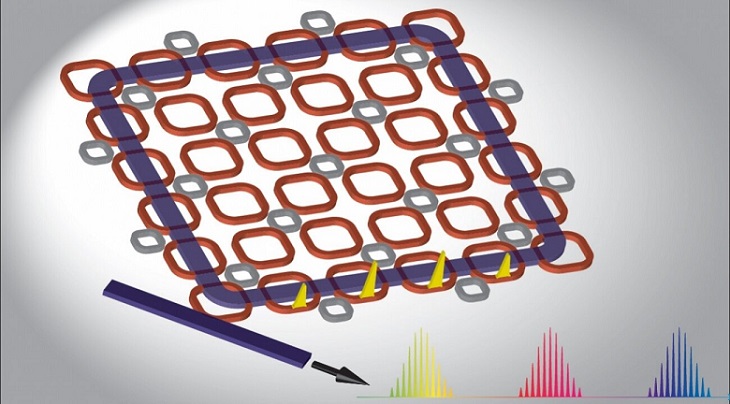Using a topological platform — topology is a field of abstract math that underlies some of the most peculiar behaviors of modern materials — researchers at the University of Maryland (UMD) have proposed a method to make chip-sized frequency combs 10x more efficient.
Postdoctoral researcher and lead author Sunil Mittal, Joint Quantum Institute Fellow Mohammad Hafezi, and their collaborators previously pioneered a micro-ring array with built-in topological protection and used it to supply single photons on demand and generate made-to-order entangled photons.
The latest work aimed to determine whether a similar setup — a square lattice of micro-ring resonators with extra “link” rings — could also be adapted to improve frequency comb technology.
In this setting, the micro-rings along the outer edge of the lattice become distinct from the rings in the middle. Light sent into the lattice spends most of its time along this outer edge and, due to the nature of the topological constraints, does not scatter into the center. The researchers call this outer circle of micro-rings a super-ring.
The team hoped to find conditions that would form a frequency comb in the pulses circulating around the super-ring. However, each of the rings in the lattice can have its own pulse of light circling around. To get one big pulse of light going around the super-ring, the pulses within each micro-ring would have to work together, syncing up to form an overall pulse going around the entire boundary.

Rendering of a light-guiding lattice of micro-rings that
researchers predict will create a highly efficient frequency comb. Courtesy of Sunil
Mittal, Joint Quantum Institute.
Mittal and collaborators were unsure at what frequency or power this would happen, if at all. To test the system, Mittal wrote a program to simulate how light would traverse the 12-x-12 ring lattice.
The team successfully identified the parameters that made the micro-ring pulses sync up into a super-ring pulse, and also found that the efficiency was a factor of 10 higher than possible for a single ring comb.
The simulation showed that the comb’s teeth were spaced in accordance with the size of individual micro-rings, or wavelengths, that fold neatly around the small circle. However, zooming in on any of the individual teeth would show that they were really subdivided into smaller, more finely spaced sub-teeth, corresponding to the size of the super-ring.
Simply put, the incoming light was coupled with a few percent efficiency into each of these extra sub-teeth, allowing the aggregate efficiency to top 50%.
The team is working on an experimental demonstration of this topological frequency comb. Using simulations, they were able to single out silicon nitride as a promising material for the micro-rings, as well as figure out what frequency and power of light to send in.
Team members believe constructing their superefficient frequency comb should be within reach of current state-of-the art experimental techniques. Such a comb could support lidar in self-driving cars as well as compact optical clocks, the researchers said. Additionally, the presence of finely spaced sub-teeth around each individual tooth could, for example, also help add more information channels in a wavelength division multiplexing transmitter.
“There could be many applications which we don’t even know yet,” Mittal said. “We hope that there’ll be much more applications and more people will be interested in this approach.”
The research was published in Nature Physics (www.doi.org/10.1038/s41567-021-01302-3).